![]()
![]()
![]()
Use LEFT and RIGHT arrow keys to navigate between flashcards;
Use UP and DOWN arrow keys to flip the card;
H to show hint;
A reads text to speech;
100 Cards in this Set
- Front
- Back
|
3 methods of sediment transportation?
And where are sediments transported to? |
Ice - Glacial deposits
Water - Fluvial (Alluvial)
Wind - Aeolian
To the sea (rivers flow to the sea |
|
|
What is a clast?
(from where? how? shape?)
|
-grain or fragment -of a rock or sediment -produced by physical or chemical fragmentation -form angular, become rounded during transport
(clast, what remains after a blast) sand, pebbles etc
|
|
|
Source of angular rock fragments as breccias |
Mass wasting |
|
|
Cross Bedding in sandstone |

sand moves up over and existing 'hill of sand' |
|
|
Ripple marks in sandstone |
Caused by flowing or oscillating water |
|
|
Graded bedding in sandstone |
caused by turbididty currents fine on topr coarse on bottome
(turbulence to shake things up and sort em) |
|
|
migration of sand dunes |
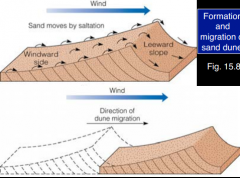
wind blows sand up one side and down the other |
|
|
types of sand dune formations |
Functions of wind and amount of sand
Transverse - over the crests Longitudinal - along the crests
Barchan - onto the bottom of U Parabolic - into the U of the parabola
Star - variable
|
|
|
Types of sedimentary rocks |
Clastic ~ 86% 11% Arenaceous - (sandstone conglomerates) 75% Argillaceous - (siltstones, shale)
Chemical & Biochemical ~ 14% |
|
|
Chemical & Biochemical sediments rock types |
Chemical carbonates - limestone, dolostone evaporates - rock salt, rock gypsum
Biochem - from organic stuff carbonate shells - chalk, coquina silicate shells - chert organic material - coal
|
|
|
Lithification |
turning fragments into rocks via compaction and cementation |
|
|
Four main groups of sandstone and where they're form |
Arkose - Alluvial fans - feldspar rich Lithic - deLtas - rock fragment Quartz - Beach/dunes - quartz (sand) Greywacke - deep sea, turbidites - matrix rich |
|
|
Sources of sedimentary rocks/minerals?
sorting and shape ? |
from mountian to sea, plus wind poor sorting and angular to welll sorted and rounded
Mass wasting - poor and Angular Glaciers - poor, less angular Pediment fans - poor, less angular Fluvial (rivers) - well and rounded point banks, flood plains, deltas Lacustrine (lakes) - well and rounded Marine - well and rounded Beach Continental margins Deep marine Aeolian (wind) - very well, very rounch, such wind |
|
|
Define metamorphism |
Changes in minerology, textre, composition Due to pressure and temperature |
|
|
Types of metamorphism |
2 Main Regional Contact
third type (less common) Dynamic - (like striking a match) |
|
|
Where metamorphism occurs |
Deep Underground Between upper and lower mantle (+T+P) Subducting lithosphere (+T+P)
Underground Surrounding Plutons (+T-P) Active Mountain belts (-T+P) Deep buried sediments (-T~P)
Oceanic Mid ocean ridges (~T-P) Continental accreation (-T+P)
Meteorites (++T++P)
|
|
|
What minerals help to disinguish metamorphic conditions |
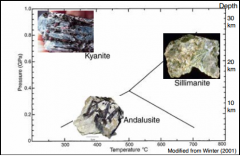
the Aluminosilicate polymorphs
Divide PT graph into 3 triangles
Kyanite - from low to high simutaneous increasing pressures and temperatures
Andaluscite - low pressures and range of Ts
Silimanite - High Ts, range of Ps
|
|
|
Indicator minerals of metamorphic facies |
Porphyroblasts fast growing Such as garnet |
|
|
Metamorphic texture |
Foliated repetative layering. parralel crystals
Non- foliated |
|
|
cause of Foliation |

2 ways
Compression stress Shear stress
Cause minerals to line up
|
|
|
Common use for slates |
roofing tile
due to excellent cleavage property |
|
|
Rock order of foliation |
Slate Phyllite schist gneiss migmatite |
|
|
rock order of mafic protoliths |
zeolitic alteration greenschist amphibolite eclogite/melt |
|
|
rock order of pelite protoliths |
Mudstone Shale slate schist gneiss granulite/melt |
|
|
Metamorphic facies |
Graph of T and P
cut off triangle from lowest T and low-ish P to highest P and high-ish T
divide triangle into 2 sections lower half into 4 T dependant sections slice the first of the 4 sections in half by P
High T+P facies are Ecologite(triangle) and Granultie
low T+P facies are Pumpellyite and Zeolite (top and bottom
from lowest corner, blueschist with High P, Green below with Higher T
Amphibolite left
then sanidinite in cornor of low P high T
|
|
|
Pelite |
Metamorphosed fine grained sedimentary rock example: metamorphism of shale to slate |
|
|
Brittle vs Ductile deformation where do these occur |
Upper crust is brittle
Lower crust is ductile
remeber strain rate has effect |
|
|
strike and dip |

|
|
|
apparent dip vs true dip |
apparent < true |
|
|
Folding Why does it occur and what doe it create? |
Compressive forces
creates Anticlines and sYnclines
shape of A and Y syncline = sink |
|
|
plunging folds |

get swiggles on surface |
|
|
types of fold |
plunging inclined recumbent - on it's side overturned folded folds - domes and basins |
|
|
2 parts of a fault |
Hanging wall - hang stuff from it
Footwall - looks like shoe |
|
|
types of faults |
Reverse dip slip fault - hanging above foot Reverse when fault dip > 45 degrees Thrust: dip < 45 decollement shallow dipping
Strike Slip dextral - to the right (D for derecha) sinistral - to the left sinister in latin = left
Normal dip slip - Foot above hanging Cause rift valleys, Horst is top (FW) Graben bottom (HW)
Oblique - both dip and strike slip
Rock joints - fracture without displacement near surface |
|
|
Types of Unconformities |
*** |
|
|
Earthquakes cause by |
build up and release of stress (seismic waves) at fault lines |
|
|
Focus and epicenter |
focus - the stress release point epicenter - the projection of the focus onto the surface |
|
|
Seismic wave types |
Body Pimary - compression waves, fast, (P for Push pull) Secondary - wavy like, half speed of P, not through liquids, (S for swerve)
Surface travel as surface ripples, slower than body Rayleigh - up and down like ocean waves Love - sideways |
|
|
Seismographs |
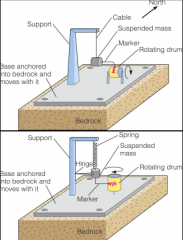
hanging marker writes on drum that's fastened to the bedrock |
|
|
importance of delay between P and S waves and rough esdtimate of what it measures |
tells how far away earthquake occured
anaagous to lightning and thunder
about 600km for every minute between (10km/s) |
|
|
calculating epicenter of earthquale |
use traingulation same as gps |
|
|
Richter scale |
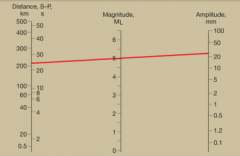
logarithmic measure of earthquake intensity
magnitude is related to the logarithm of seismic wave amplitude
empirical methods tho |
|
|
Speed of body waves through the earth |

Speed is affected by density and strength quickens through solid increasing density mantle drops as enters core due to sloid/liquid strength drop, then increases again due to increasgin density |
|
|
effects of earth layers on body wave |
p waves are refracted and reflected at density boundaries
s do not pass into core |
|
|
what can be learned from studying P and S wave behaviour through the earth? |
the depths and densities of the various layers of the earth |
|
|
Pangea continent fit noticed by |
Francis Bacon (kevin's great great great grandpa....)
1660 |
|
|
Evidence for continental drift |
Five pieces 1. unique repitles in fossil record on different continents 2. rock sequences 3. mountain ranges across continents 4. Glacial striation dircetion 5. mid ocean ridges
in the rocks, the rocks, what the rocks make up, ontop of the rocks, and between the rocks( continents) |
|
|
the cause of earths magnetic field |
rotation of the inner and outer cores, electrical current causing an electrical field |
|
|
record of the magnetic field |
found in old rocks that contain magneitite |
|
|
Polar wander |
assuming the poles have not moved, the continental drift path can be reconstructed from magnetic rock orientation for various dates
on a current world map, it traces the path of the apparent polar wander |
|
|
magnetic reversal |
the magnetic field can reverse and does so on a irregular basis according to a timescale of a few thousand years |
|
|
Evidence of magnetic reversal |
revesed magnetic lava sequences |
|
|
determining the age of the sea floor |
can be determined from magnetic patters due to lava from ocean rigdes |
|
|
Puzzle pieces as to how continental drift occured three parts of plate tectonics |
mid ocean ridges deep ocean trenches transform faults |
|
|
divergent plate boundaries |
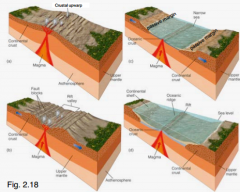
plates splitting
magma goes up through cont crust creates a rift, fills with water, continues to add magma pushing sides apart |
|
|
Passive vs active continental margins |
passive - only accumulate via sediments, close to an ocean ridge
active - at subduction zone, where |
|
|
Ophiolites |
ocean crust obducted onto continetal crust |
|
|
Deep-ocean trenches |
where plates converge and subduct |
|
|
Island arcs |
where an oceanic plate is subducted another oceanic plate (Ocean-Ocean)
pushes land up on the lighter plate, older plate melting creates volcanoes and stuff, more land forms |
|
|
Continental arcs |
Oceanic plates subducts beneath continental plate
subduction melting magmas rising more land |
|
|
Transform faults |
plates sliding past each other necessary because earth is a sphere |
|
|
continental collision |
plates collide and all of the subduction ocean crust gets subducted then it's continent on continet and crazy big mountains! from lower plate pushing back up |
|
|
WILSON CYCLE |
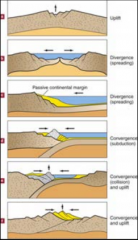
1. Continental rifting 2. Ocean basin spreading 3. Ocean closure 4. Collision
takes about 500Ma |
|
|
Hot spots |
Hot plume of lava at a point on the mantle and a plate moves through it.
isalands and such area created in a line as the plate moves by |
|
|
Flood basalts |
casued as plume head reaches the surface |
|
|
driving force of plate movement |
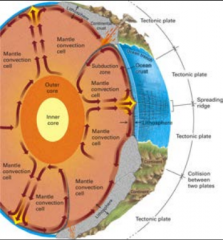
ridge push and slab pull
push - uplift due to hot magma pull - sinking of colder denser ocean plate
related to over matle convection |
|
|
Literal Biblical time line of earth |
Bishop Ussher 9AM Sunday 4004BC Life on tuesday |
|
|
Major scientific dates for evolution of life |
~4.55 Ga Earth formed ~3.85 Ga Life began ~560 Ma Phanerozoic period ~4 Ma Earliest human ~200 Ka HomoSapiens ~11.5Ka Last ice age ended |
|
|
Geological time scale |
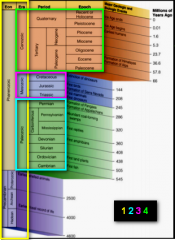
http://geophysics.ou.edu/geol1114/notes/time/time_scale_mnemonics.htm
|
|
|
Principle of uniformitarianism |
-processes today, likely operated in the past -we can use present day understanding to understand geological record |
|
|
6 principles of uniformitarianism |
The principle of: 1. Original horizontality 2. Superpositions (young on old) 3. lateral continuity (layers laterally extensive 4. Cross-cutting (intrusions or faults must be younger than than the rocks they cross/cut) 5. inclusions (they must be older than the host rock) 6. fossil succession (fossils at bottom older than ones at top) |
|
|
Types of unconformities |
Breaks in the geological record
Disconformity (erosions in rock sequences that remove some layers) Angular (erosion surface on tilted area) Nonconformity (erosional surface on metamorphic or igneous rocks after uplifiting and more deposits on top) |
|
|
First geological map of GBR |
William Smith (this is the story of about how, will smith made a map of the rocks in the ground) |
|
|
Absolute dating |
using radioactive isotopes to date rocks run through a mass spectrometer |
|
|
Important dating isotopes |
Carbon 14 half life of 5730 years present in living organisms stars to decay on death of organism
U238 10Ma to 4.6Ga U235 10Ma to 4.6Ga Th232 10Ma to 4.6Ga Rb87 10Ma to 4.6Ga K40 100Ka to 4.6Ga |
|
|
Evolutionary path of major species |

old to new
jawless fish bony fish cartilagenous fishes jawed fishes Amphibians Reptiles Mammals Birds |
|
|
precambrian was how much of earths history |
88% |
|
|
Archean cratons |
occured in the archean eon the start of the continental plates accreation of lighter felsic materials mostly granite green-stone |
|
|
evidence for archean cratons forming on the seafloor |

pillow lavas eruption and solidification as small bloops |
|
|
archean greenstone belts |
layers of granite/gneiss layers of ultra mafic lava (komatiites) (due to hotter temperatures) layers of basalt layers of sediments
|
|
|
Plate stuff of the protorezoic |
supercontinents! - Rodina (laurentia was in continent in it) banded iron formations |
|
|
orogenies |
forces and events surrounding formation of orogens, large strucutral deformation of plates colliding making mountains.
major grenville orogen making mountains all down the east side of north america and scotland to scandanavia |
|
|
oxygenation of earth (atmosphere and oceans) |
1% of present, near the start 10% proerozoic current levels acheived in paleozoic
|
|
|
Definition of life |
organism that can reproduce and metaboloize |
|
|
Origin of life how and evidence |
triggered in chemical materials by energy source (lighniting radiation seafloor vents)
Stanley miller (library guy) synthesized amino acids
|
|
|
Archean life |
oldest indisputable evidence from stromatilites sediments pulled onto rocks by algae |
|
|
prokaryotes |
-earliest life forms (archean) -single celled -anaerobic - no O2 req'd -heterotrophic - derived nutrients from outside sources -no fossil record |
|
|
proterozoic life |
aerobic eukaryotic (has nucleus, will live) sexually reproductive cells
multicellular life in early era (probably, fossil issues)
ediacaran fauna later in era are preserved |
|
|
Rock stuff of paleozoic |
continental platforms - on shield margins sedimentary rocks on top
Mobile belts - @ cratonic margins |
|
|
Cambrian explosion |
rapid evolution of life
maybe the warm shallow seas
burgess shale in BC is great fossil record |
|
|
Major Paleozoic fossils |
-Cambrian - Trilobite, major hard shelled invertabrate, important becuase it's wel preserved - Pikaia, first chordate fish (animals with spines, tails and nerves etc) Silurian - Cooksonia, earliest vascular land plants - Graphtolites Devonian - Gastropods, - Cephalopods, - Echinodermata Permian - Glossopteris, cont drift evidence
|
|
|
major events in paleozoic |
Cambrian - life explosion, fish and plants Ordivician - towards the endmass extiction (ice age?) Silurian nothing Devonian - reefs, economic sources (evaporites-potash), - Major shale deposits, Oxygen increase to modern levels!!! (400Ma) - plants, tall and with seeds. - insects. - AGE OF FISH another mass extiction (ice again) Missisippian nothing Pennsylvanian - Coal swamps (found in PN), - forests, - reptiles Permian - pangea, - maybe warm blooded mammal ancestor. - REALLY BIG EXTINCTION
|
|
|
When was break up of pangea |
mesozoic 245Ma |
|
|
Mesozoic events |
Triassic N.america starts to rift away. western volcanoes form Jurrasic more rifting, south atlantic ocean est. western N.A accreates. western mountains. AGE OF REPTILES Cretaceous greenland and india take off mammals that give birth flowers mass extinction, (chicxulub meteorite) |
|
|
first recognized bird |
archaeopteryx. Feathers! |
|
|
mountain building, how? |
lots of sediment, plate crash, push waves of sediments |
|
|
Cenozoic events |
Miocene epoch India to asia and africa to europe Pleistocene Ice age! |
|
|
Continental stuff of Paleozoic |
Cambrian - several continents Ordivician - Gondwana Glacier - taconic orogeny Sillurian - Baltica crash with Laurentia - caledonian orogeny Devonian - Laurentia towards Gondwana Missisipian - more ice Pennsylvanian - Laurentia + Gondwana together at last <3 Permian - Panea!!!! wohoo (hot and dry) |
|
|
Continental stuff of Mesozoic |
Triassic - Laurasia + Gondwana no more :'( start to break apart and drift away Jurrassic - Central altlantic rifting Cretaceous - Atlantic ocean is quite big now. "Player 2 has entered the game" Greenland becomes it's own thing. Indian airlines, India cruising northwards at an altitude of sealevel |
|
|
Continental stuff of Cenozoic |
Paleogene - some orogenies Neogene - India has reached it final destination. Africa kills old man Tethys Quarternary - Basically now, but with more ice!! |

